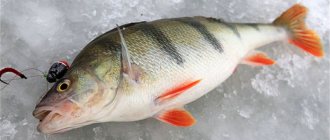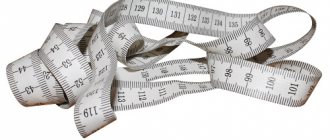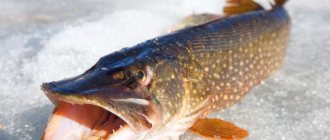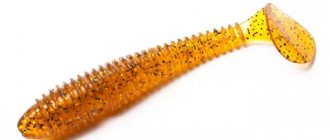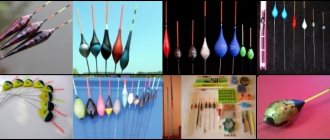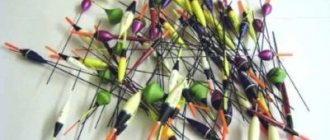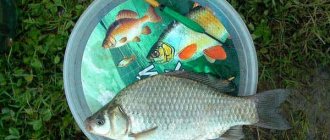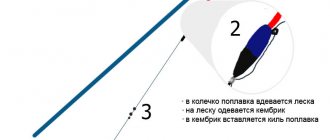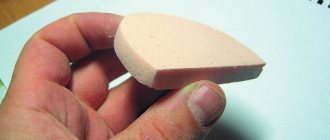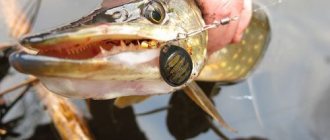Crucian carp is one of the most common fish in Russian reservoirs. And the most common catch for domestic fishermen. The easiest way to catch it is with a float rod, however, this simplicity does not mean that you can be careless in choosing the elements of equipment. There can be no trifles in this matter, especially when we are talking about such an important detail as a float.
The wrong choice of this part can lead to complete failure of fishing. After all, it is she who signals the bite and makes it clear to the fisherman at what moment to hook.
Criteria for choosing a float for catching crucian carp
The bites of crucian carp are not distinguished by persistence and aggressiveness, so the main criterion when choosing a float is its sensitivity. It should be maximum: the sensitive float must respond to even the weakest touches of potential prey on the bait, sinking into the water or rising up.
Sensitivity depends on the following factors:
- Load capacity. The smaller it is, the higher the sensitivity.
- Top thickness. The smaller it is, the more sensitive the float.
- Body thickness. The thinner and more elongated the main part, the more sensitive the alarm.
Consequently, a float for catching crucian carp should not be very large, have an elongated rather than barrel-shaped shape and, most importantly, a thin tip.
To choose the right float for crucian carp, you need to clearly understand the structure of the product. Its constituent parts are:
- antenna located above the water;
- body;
- keel - underwater part;
- waterline is the boundary of a watershed.
Changing any component element radically changes the functions and purpose:
- Strength and service life depend on the material from which it is made.
- Stability in wind and current depends on the length of the keel.
- Its ability to resist wind depends on its carrying capacity.
- The longer the antenna, the more noticeable the bite.
- By changing the shape of the body, you can adjust the sensitivity.
- The size should be larger, the stronger the wind.
It was experimentally found that the best floats for crucian carp have the shape of a spindle, with a width to length ratio of 1:7. If loaded correctly, they have excellent sensitivity and can be used in still water as well as in fast currents. An increase in weight leads to an increase in the resistance of the product to waves and wind.
Optimal weight
The weight of the float is selected depending on the fishing method and conditions. In calm water and in the absence of wind, alarms weighing two to three grams are used. In windy weather and during currents, five to seven gram products are used. For long casts, choose models weighing up to ten grams.
It should be taken into account that as the carrying capacity increases, the sensitivity decreases, so you need to use the lightest models that the fishing conditions allow.
What should the color be?
The color of the product is not particularly important for fish. It is important for the fisherman so that the signaling device is clearly visible on the water. Therefore, it is recommended to purchase collapsible alarms with replaceable antennas. In clear weather, on light-colored bodies of water, the black and red tips are more noticeable. On cloudy days, on dark water – white and light green.
The color of the keel should not be too bright so as not to stand out in the water column and not to scare away potential prey.
The best manufacturers and models of floats for crucian carp
Stores offer many different types of floats with very different prices. The cost of a product depends on its quality, the material from which it is made and the brand. For amateur fishing, any option that meets the requirements listed above is suitable. Sport fishing requires a more serious approach to the choice of product material and manufacturer.
The most important sign of a high-quality float is how firmly and securely the top and keel are held in its body. The strength of the product despite its small size also plays a significant role. In the manufacture of high-quality alarms, modern materials are used: plastic for the top and carbon for the keel.
The best material for the body is considered to be balsa - the lightest wood in the world. The finished product is coated with a layer of varnish to protect it from exposure to a humid environment.
The best manufacturers on the market are:
- Expert.
- Salmo.
- Xtro.
- Tubertini.
- Maver.
- Colmic.
- Milo.
At the same time, a goose feather is still considered an unsurpassed “crucian carp” float, although now it has become very rare.
The sensitivity of floats - myth and reality
It is well known that the success of all fishing largely depends on the sensitivity of the float tackle. What kind of sensitivity there is and what it depends on - we will try to understand this material.
To begin with, let's do one simple experiment. Initially, we will load two floats, diametrically different in shape and weight, equipped with hollow antennas of the same diameter and length, at the base of the antenna, as shown on the left side of the figure. Then we will add another shot to each rig so that the antennas of both floats are equal to the water level, as shown on the right side of the figure. With these pellets we will simulate a fish bite on a drowned fish. Dynamic sensitivity can also be measured at home by comparing equipment with floats of the same weight but different in shape.
Quite naturally, the left float in the form of a flat tablet turned out to be several times less sensitive, because for its synchronous immersion, the weight of an additional pellet was required several times greater than for the right spindle-shaped float. It will be much more difficult for a fish to sink a parachute-shaped float than a more elongated float. It follows from this that, with equal weight parameters of the floats and the same diameters of their antennas, the dynamic sensitivity very much depends on the shape of the float. So far we have been examining generally understandable and well-known phenomena.
Now let's go further and take two floats of the same shape and weight with hollow antennas of the same length, but different in diameter (1mm and 2mm), as shown on the left side of the figure. Then we will add pellets to both rigs so that the antennas of both floats are again equal to the water level, as shown on the right side of the figure. With these pellets we will again simulate the fish biting on the drown.
Now is the time to remember Archimedes’ law, according to which a body immersed in a liquid is acted upon by a buoyant force equal to the weight of the liquid displaced by the body. It follows from this that the determining factor in the static sensitivity of a float is the volume of its antenna. The volume of a cylindrical antenna depends on its diameter and length. From the school mathematics course, we calculate the volume of two antennas with a diameter of 1 mm and 2 mm and a length of 50 mm. V1= 39.25mm3. V2= 157mm3. As we can see, the volumes of the antennas differ by a factor of 4. Fishermen with impaired vision find it difficult to distinguish a thin antenna at a great distance, so they are forced to use floats with thicker antennas, to the detriment of the sensitivity of the gear.
Is there a way out of this situation? Of course have! There are several ways to increase the sensitivity of a float with a thick antenna. Let's look at some examples:
1. Initially, load the float with a thick antenna so that only a small part of it protrudes above the water, sufficient for reliable visual contact. Then the remaining part of the antenna above the water will become shorter, which means that its non-immersed volume will become smaller, and the sensitivity of the equipment will increase. Let's look at this method using an example. Volume of a thin antenna with a diameter of 1 mm and a length of 50 mm = 39.25 mm3
To maintain the same sensitivity for an antenna with a diameter of 2 mm, you need to leave the same volume of 39.25 mm3 above the water surface. Then the length of the part protruding above the water should be: 39.25: 3.14*12 = 12.5 mm, and for an antenna with a diameter of 3 mm above the water you need to leave only 5.6 mm. In principle, such an antenna can still be distinguished on the water at a fairly large distance.
2. Instead of a thick antenna, you can install a thin one, but you need to put it on its tip, or glue some kind of knob, like a bright silicone or foam ball with a diameter of 5 - 7 mm. Then the fisherman’s vision will be better able to distinguish this object, and bites will become more noticeable. However, if the ball itself is drowned along with the antenna, the sensitivity at this moment will sharply decrease, because the ball also has a volume that did not affect sensitivity while it was above water.
3. Make a homemade antenna from colored plastic from an empty beer bottle, or a PET bottle of a different color. The antenna will require a strip of plastic 40–60mm long and 4–6mm wide. We bend the cut strip in half along its entire length. In cross-section we get the Latin letter V. We will sharpen one end of the curved strip so that it is easier to stick it into the body of the float instead of a thick antenna. Fill the joint with SuperMoment glue. The thickness of the plastic varies within 0.2mm. With a strip width of 5mm and a length of 45mm, we get the volume of our homemade antenna: 0.2*5*40 = 40mm3. Don't forget that 5mm of the antenna length will be glued into the body of the float. Thus, we got a very noticeable antenna with a pseudo diameter = 2.5 mm and a volume like a thin round antenna with a diameter of 1 mm. This is perhaps the most effective way to simultaneously obtain a very visible antenna and its minimum volume, which means quite high sensitivity. A similar solution is used on match floats with a large-diameter hollow end-to-end antenna.
In conclusion, we will move on to our latest experience and dispel one very common myth. I have repeatedly read in many popular fishing publications the erroneous statement that floats with metal antennas are the most sensitive. Now we will check this using the same experiments and precise medical scales.
And so again we take two floats of the same shape and weight with antennas of the same length and diameter, but made of different materials. The left antenna will be hollow and made of plastic, and the right antenna will be made of lead to make the experimental result more convincing. We surround both equipment in the same way as before, along the base of the antenna, as shown on the left side of the figure. Then we will add pellets to both rigs so that the antennas of both floats are again equal to the water level, as shown on the right side of the figure. With these pellets we will once again simulate a fish bite on a drown.
Now let's weigh the added pellets again, with which we sunk both float antennas to the water level, as shown on the right side of the picture. Surprising as it may seem, the weight of the added pellets again turned out to be the same, which means the static sensitivity of the floats with hollow and solid metal antennas is absolutely the same, and it could not be otherwise. After all, Archimedes derived his law so that we could use it. Now is the time to summarize the theory of sensitivity of float gear. The static sensitivity of the floats depends ONLY on the diameter of the antennas and in no way depends on the material from which it is made.
The thinner the antenna, the higher the sensitivity, and vice versa. The thinner the antenna protrudes less above the water, the higher the sensitivity again, and vice versa. The more elongated the float, the higher the dynamic sensitivity, and vice versa. However, this does not mean that the shape of the needle or elongated spindle is the best. It all depends on the specific fishing conditions. When fishing in the current with a hold, or even a complete stop, the most acceptable shape of the float will be spherical. Such a float will not lie on its side and will show a bite much better than an elongated one, despite the rather poor dynamic sensitivity.
Let's take a little break from sensitivity and turn our attention to the floats themselves. There are floats with carbon fiber and metal keels on sale. The specific gravity of carbon fiber plastic and metal alloy is different, which means that the dead weight of such floats will be different, even if they have the same shape and declared load-carrying capacity. In such equipment, the weight of the float and sinkers is again redistributed. In practice, this means that when loading a float with a metal keel, the total weight of the pellets will be less than for the same float, but with a carbon fiber keel. When casting with a long, blind fly rod, such equipment flies worse than equipment with a float on a carbon fiber keel. This is especially noticeable on long casts with light equipment and with shallow depth in the fishing area. When casting, a heavier float and a lighter sinker tend to rotate relative to each other, and this often leads to tangling of the entire tackle. The same effect can be obtained if metal antennas are used to pseudo-increase the sensitivity of the float.
In addition to this harmful phenomenon, another disadvantage appears as a side effect. With the same stated weight of the floats on equipment with a metal keel, the total weight of the pellets turns out to be less than that of equipment with a float made of carbon fiber keel, which means that during the current the nozzle will reach the bottom more slowly. When fishing with wiring, this is a fairly important success factor. To speed up the lowering of the nozzle to the bottom, the fisherman is forced to use floats of greater carrying capacity and size, whose sinker weight will naturally be greater. And this, in turn, leads to coarsening of the entire gear and a decrease in the dynamic sensitivity of the equipment. As a result, there is a clear deterioration in the results of the entire fishing trip.
As we have seen, in a simple float tackle everything is interconnected. From here we can formulate another important principle: The smaller the dead weight of any float, the greater the weight of pellets required to load it, and this is one of the main rules when equipping any fly fishing rod and one should strive for it.
Source
Choosing the right uniform for the weather
The optimal conditions for fishing with float tackle are calm weather and still water. In these conditions, you can use the lightest alarms with the greatest sensitivity. However, calm is a rare gift for the fisherman. Usually you have to fish in wind and waves of varying strength, in which it is impossible to notice bites using light alarms. Therefore, depending on the weather, floats of various shapes are used.
Complete calm
In this case, the following types are used:
- Needle, goose feather. They weigh up to three grams and can be loaded with a weight of up to four grams. Used for short casts.
- Drop, spindle. They are heavier. They can weigh up to eight grams with a load of four to six grams. Suitable for long casts.
Windy weather
In this case, the choice depends on the wind strength:
- Olive. Used in light winds and small currents. Poorly transmits the bite on the rise.
- Inverted drop. It reflects the rising bite well and stays stable on the water in strong waves.
- Spherical or disc-shaped. It weighs a lot - about ten grams plus a load of 4–10 grams. Used in strong winds and fast currents.
As you can see, an important role in the selection of a signaling device is played by its shipment.
Types of floats
All float products perform the same function - they report a bite. Essentially, the principle of operation is the same. When the fish starts to bite, then the bite indicator reacts and begins to move or sink.
Floats differ in shape, weight, size, color and type of material from which they are made.
Conventionally, they can be divided into several types:
Teardrop-shaped. Very good for deep fishing. It has a low center of gravity, is very stable and shows a bite even in choppy water.
Spindle. This species is very sensitive and is needed for catching cautious fish. It is advisable to use only for fishing in still water (stakes, lakes, ponds) with a depth of no more than three meters.
Flat. Needed to fish in strong currents. Fishermen mainly use it for fishing in rivers. It looks like a disk to which, at an angle of forty-five degrees, an antenna with a keel is attached.Ball. Very stable in strong winds.
Straight. One of the most common. It has a rather simple shape. Suitable for fishing in good weather, in reservoirs with a depth of up to two meters.
Read here How to tie a fishing line to a reel - methods, tips on how to tie correctly and an overview of the most reliable knots (85 photos and videos)
Inverted drop. An ideal choice for fishing at great depths with underwater currents.
Olive. Used under different fishing conditions: waves, wind, calm weather. A fairly stable float, and essentially universal.
Double sided cone. Suitable for fishing on canals with weak and medium water flow. Very stable due to the long keel.
How to properly load a float for catching cautious crucian carp
For fishing to be successful, it is not enough just to choose the right alarm. It is important to properly load the float for crucian carp fishing. It depends on how timely your cuttings will be.
Properly loaded, it floats on the water in such a way that its antenna is completely above the water. This allows the angler to understand from the state of the float what is happening with the bait under water and minimizes the resistance that the crucian carp feels at the moment of biting. This is important because crucian carp are very careful and will throw the bait at the slightest resistance.
Loading floats onto crucian carp can be done both at home and directly on the pond.
At home, the loading process looks like this:
- Pour water into a cut plastic bottle with a volume of one and a half to two liters, into a deep saucepan or into a bucket.
- At a distance of ten to fifteen centimeters up from the hook, attach a clamp with a pad (the smallest weight).
- Having retreated another fifteen to twenty centimeters upward, they attach three to four pellets with a step of five to seven centimeters between them.
- After installing each pellet, check how much the signaling device is immersed.
- By removing or adding weights, ensure that only the tip of the alarm rises above the surface of the water.
It is almost impossible to achieve correct loading at home, since the depth of the reservoir differs significantly from the depth of the container used at home. Therefore, it is best to devote some time to this operation directly while fishing, which will allow you to achieve an optimal position.
Most often, inexperienced fishermen incorrectly distribute the weight of lead pellets or use only one pellet. Another common mistake is to attach larger, heavier shot closer to the hook. All this scares away potential prey.
Which float is suitable for crucian carp?
It is impossible to single out a universal float for such delicate fish as crucian carp. Weather conditions, fishing location and a number of other features should be taken into account.
Calm weather.
In such conditions, a “needle” is ideal, as well as a “goose feather”, which have increased sensitivity. The behavior of such floats allows you to see the moment when the crucian carp swallowed the bait.
Windy weather.
In the presence of wind, all two previous types of floats lose their properties. In this case, any float for the current will help. It allows you to carefully load the gear. This species does not react to waves and allows you to hook crucian carp in time. In conditions of strong current, floats with increased carrying capacity are suitable.
It is worth noting that the bite of crucian carp in strong currents is reduced to a minimum.
Is it possible to make a float yourself?
It's no secret that one of the best floats for catching crucian carp is a goose feather. It is quite functional and practical. The main advantage of such a device is the ability to make it yourself. To do this, you will need to clean the feather with a knife, and then attach it to the top of the float mark. A nipple with fishing line is installed on the lower part of the feather.
From all of the above, we can conclude that the size of the catch directly depends on the correct choice of float. This is especially true for crucian carp. Before settling on one model or another, you should pay attention to the weather, the presence or absence of a current, as well as other factors.
Also, remember that buying a float does not promise great results. Often homemade devices turn out to be more practical and effective.
What characteristics should a modern float for crucian carp meet? First of all, it must have high sensitivity, which allows it to notify the fisherman of the slightest contact with the fish. The signal is given by periodic raising and lowering. This is typical when crucian carp lifts not only the bait, but also the ground weights.
One of the purely crucian floats is the goose feather. Despite the fact that this method of catching crucian carp was invented by the forefathers, it is extremely popular and is actively used today, still being the most correct and unique option for a float for crucian fish.
What kind of water do we fish on?
The place for fishing is usually chosen in advance, so the equipment is prepared depending on the type of reservoir on which it is intended to fish.
Still water
Fishing from the bottom in calm conditions in reservoirs with no current allows you to use the most sensitive signaling devices - “goose feather”, “needle” and “extended spindle”.
They catch the slightest vibrations of the fishing line under water and do not allow you to miss a single bite.
Areas with current
The current constantly carries the float, deflects it to the side, and places it on the water. Therefore, it can be difficult for an angler to distinguish a real bite from a false one. To minimize the number of false signals, choose spherical or disk-shaped models, or a “reverse drop”, in which the pointed part is in the water and the convex part is above it. To increase the stability of the float, increase its weight.
In weak currents, “olive” and elongated models are used. On the strong side - flat shapes.
What should a float be like for crucian carp?
However, the sensitivity of the float may depend on the following factors:
- The main argument in this situation is its carrying capacity
. Following the drawn up proportion, the load capacity will be less, which means that the sensitivity of the float will increase, and vice versa. However, we should not forget that extremely sensitive floats are more difficult to cast over long distances when the fisherman is fishing from the shore. Catching crucian carp at depth with an extremely light float also does not bode well, because there must be a balance. - The second factor includes the cross-sectional area of its tip
. The sensitivity of the float directly depends on the thickness of its upper part. - The third and final factor is the influence of the cross-sectional area of the main part of the float on its sensitivity. As in the second case, the thinner the body of the float, the more sensitive it will be.
From which we can deduce the following information about the float for crucian carp:
- The float should not be barrel-shaped. Only extended.
- Its tip should be thin.
- The mass of the float should vary within the average norm, but deviating from the more massive option.
What kind of float should be for a certain equipment?
Experienced fishermen choose floats depending on the type of fishing rod used for crucian carp.
- A fly rod is used when fishing at shallow depths, which does not exceed two-thirds of the length of the blank, using short or medium casts. In such conditions, lightweight floats weighing up to three grams in the form of a drop, reverse drop or spindle are needed. You can attach the float in any way.
- The match rod works for medium and long casting and can be used on any water. They are equipped with signaling devices in the form of a needle or spindle, which are fixed at one point.
- A plug rod is used for casting up to eighteen meters, equipped with a flat float with two fixation points.
- The Bologna rod is used for long casts, up to thirty meters. During currents, it is equipped with a petal-type float. In still water - in the shape of a spindle or drop with a long keel and tip. Fix the alarm at two points.
Sliding equipment
The sliding float on the crucian carp can move along the fishing line and is stopped with the help of a stopper. This equipment is used in cases where it is necessary to make an accurate long-distance cast to a depth significantly exceeding the length of the rod. This type of equipment allows you to fish at any depth in windy weather.
The assembly algorithm for such gear is as follows:
- The line is passed through all the rings on the rod.
- Install the top stopper.
- Attach a sliding float.
- Install the lower stopper.
- Secure the sinkers.
- Attach a hook.
For installation, it is better to take monofilament fishing line - it is smooth, so the float will slide better. If you use a small carabiner between the two stoppers, you can very quickly change the weight and shape of the float without disassembling the entire tackle.
How to choose a float based on fishing conditions
The choice of float often determines the effectiveness of fishing. A correctly selected and correctly loaded bite alarm will ensure the delivery of bait to the specified fishing horizon and will allow you to register the slightest touch of the fish to the bait.
Float for fishing in calm water
When fishing on ponds and lakes, most anglers use amateur versions of bite alarms, loaded with one sinker and protruding 10–15 centimeters from the water. This approach to constructing equipment may bring some results, but it is unlikely to provide the fisherman with a decent catch. For fishing in still water, you should use a sports model characterized by:
- short keel no more than 7 cm long;
- a body that has a widening at the bottom and gradually tapers at the top;
- thin plastic antenna in a one-piece design.
The short keel and pear-shaped shape will ensure the stability of the float even in strong waves. Loading is done in such a way that in the working position the antenna sticks half out of the water. The bulk of the sinkers are located a meter from the connection of the leash and the main fishing line. Another 3-4 small pellets are attached 30–50 cm from the connecting node. A small sinker is placed close to the knot. This immersion method allows the bait to slowly sink to the bottom, which does not alarm nearby fish.
If the carrying capacity of the float exceeds 3 g, in order to avoid frequent tangling of the equipment, instead of a set of upper sinkers, an olive weight is installed on the fishing line, locked on the main monofilament using small lead pellets.
For fishing in ponds, you should use models with a carrying capacity of 0.5–1 g, which will allow the equipment not to create a lot of noise during splashdown and will not alarm underwater inhabitants in shallow water. In small, closed reservoirs there is no such strong wind and big waves as in open space, so the use of light floats for fishing is quite justified.
When fishing at a depth of 2–3 m, it is better to use a bite alarm with a carrying capacity of 1.5–2 g, which will speed up the delivery of bait to the bottom and make fishing more dynamic. If fishing is carried out at depths of 3–7 m, then you will have to use floats with a carrying capacity of 2.5–6 g. You should not be afraid of the loud splash of the equipment on the water during splashdown, since at great depths the fish does not pay attention to weak surface sounds.
Float for fishing in currents
Models for fishing in currents are radically different from those used for fishing in still water. Their main differences include:
- body shape close to spherical;
- hollow antenna;
- long keel.
A spherical body, in contrast to an oblong one, is less subject to the pressure of a directional flow of water, which has a positive effect on the sensitivity of the equipment. The hollow antenna has its own buoyancy and does not go under water when sinkers pass various bottom irregularities. The long keel ensures the float a vertical position even in strong currents.
When fishing in a weak current, the same type of weight is used as when fishing in calm water. If fishing takes place on a river with a medium current, models with a carrying capacity of 4 to 8 grams are used, loaded with one sliding sinker. The immersion depth of the equipment is adjusted so that it is one meter more than the actual one. During fishing, the sliding load, carried by the float, drags along the bottom. This method of loading makes it possible to thoroughly fish all the unevenness of the bottom topography.
If the water flow is very strong, as often happens during high water, then you can only fish with a plug rod equipped with a flat float. Flat models perfectly resist currents of any force and are able to register careful fish bites. The load of such a signaling device consists of 1-2 small lead pellets located 40 cm from the hook, and the main load located a meter above.
For fishing in the wind
In windy weather, you should fish with models with a long body and a lower attachment point. A long alarm will not be overturned by waves, and a low mounting point will reduce the influence of surface current on the fishing line, which will also have a positive effect on the stability of the float.
To be able to cast the tackle in windy weather, the load capacity of the float must be at least 4 g. If we are talking about long-distance fishing, then the total weight of the equipment can reach 15 grams.
For catching small fish
Small fish are caught in shallow water using short rods, so light alarms with a load capacity of 0.1 to 0.5 grams are used for fishing. The keel of such models is very short, which allows the float to take its working position immediately after splashdown, which is very important when fishing at shallow depths.
The sinker is located 10 cm from the hook. The bulk of the loads are attached 15 cm higher. In such a rig, you cannot place one large weight instead of the top set of sinkers, as this will result in tangling of the main line and leash.
For long casting
For fishing in calm weather, at a distance of 15–20 m from the shore, a match model with its own load of 2–4 g is quite suitable. When fishing at a distance of 20–30 m, you should use heavier options weighing 5–8 g. If you plan to fish at a distance of 40–60 m, you will need a signaling device with its own load of at least 10 grams. and a sliding mounting option.
The equipment must be mounted in such a way that 70–80% of the total weight of the weights is concentrated inside the body or moved close to it, which is necessary for long casting and to prevent tangling of the monofilament.
To increase the flight range, match models are equipped with plastic stabilizers that improve their aerodynamics. To make bites visible from a long distance, a bright-colored hollow cap is placed on the alarm antenna, which has zero buoyancy and does not affect the sensitivity of the gear. Since match fishing involves power casting, the bite alarm must be securely attached to the main line using a connector.
Floats for live bait fishing
To fish for predators using live bait, models with a carrying capacity of 3–10 grams are used, which allows you to throw the bait quite far from the shore. Such alarms are loaded in such a way that 20% of their body protrudes above the surface of the water. Such a load is needed so that the live bait cannot sink the float on its own. The live bait float is loaded with a stationary olive sinker.
